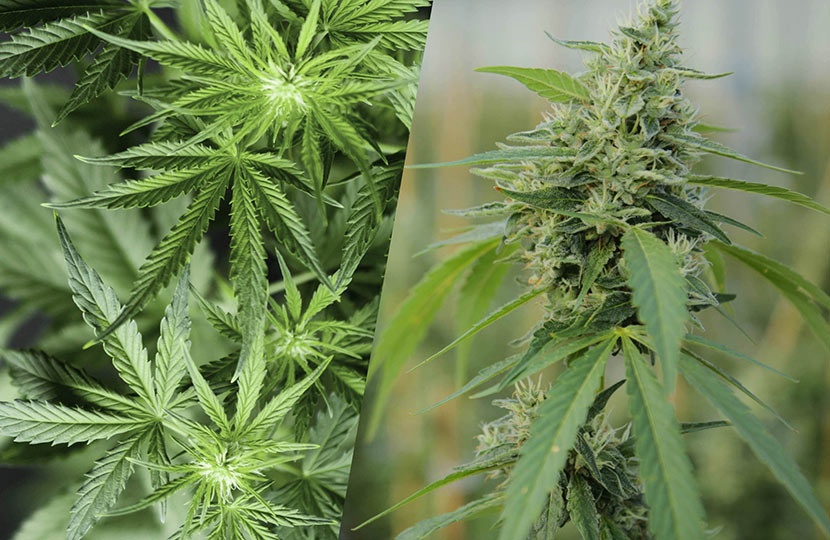As you get nice and cozy in the cannabis community, there are two terms you run into a lot: hemp and marijuana. When you hear these words, you may wonder: Is there a difference? Can they be used interchangeably? Or are they discussing two distinct types of cannabis? Understanding the difference is more important than you may realize, especially when shopping for products. For that reason, we’re looking at hemp vs. marijuana to point out what makes them different.
What’s in a Name?
So first off, let’s get one thing clear: marijuana and hemp are technically the same. Regardless, there are some key differences that are important not only for how they affect you, but for overall accessibility as well.
The only real thing that sets the two apart is a little cannabinoid we know all too well as THC. Cannabis sativa plants with under 0.3% THC are considered hemp, while those with THC content above that level are known as marijuana.
In terms of actual genetic makeup, this is the only true way to separate the two types of cannabis. According to Ernest Small, author of “The Species Problem in Cannabis: Science & Semantics,” hemp and marijuana are taxonomically the same. With this in mind, he came up with the idea to categorize cannabis plants with 0.3% or less THC as “hemp,” and this would later serve as the basis for establishing the 2018 Farm Bill.
For the purposes of this discussion, we refer to the other type of cannabis as “marijuana” since it’s still a common term, though the industry is looking to phase it out due to its problematic history. Not only was it used in reference to a stereotype that people migrating from Mexico smoked this plant in excess, but it became entangled in early efforts to turn public opinion against cannabis. You will find that it’s a word we do not use outside of this context, though unfortunately, a proper alternative has yet to be established.
Because of its higher THC levels, consumers usually turn to marijuana for a stimulating experience. Hemp, on the other hand, is typically used for a variety of purposes, including industrial materials, fuel, and therapeutic CBD products. When hemp is consumed, you won’t experience the energizing head buzz that may come from consuming marijuana. Because of this important distinction, hemp is largely legal while marijuana’s legality is far more limited.
Cannabinoids aside, these two types of cannabis can differ in how they grow. Hemp takes longer to reach maturation but is easier to cultivate while marijuana has a shorter growth cycle and thrives under controlled conditions. Both plants can appear tall with visible stalks and thin leaves, though certain species of marijuana will be short and bushy. The buds on marijuana plants are abundantly covered with a thick, sticky resin containing most of that strain’s cannabinoids. There isn’t as much resin found on hemp, though it still has plenty of cannabinoids — they’re just packed into the leaves.
Having origins in Southeast Asia, cannabis sativa has become the most abundant type of cannabis, with quite a diverse range of strains accounting for both hemp and marijuana. Cannabis indica, on the other hand, belongs exclusively to the marijuana category. It can thrive in much cooler climates and is easier to grow inside because it’s shorter and bushier than sativa plants.
When looking at hemp and marijuana, it’s important to understand how strain and species differ. Sativa and indica are different cannabis species, and within those species, you have a multitude of strains. While both hemp and marijuana are genetically similar, their chemical compounds make them two different strains of cannabis. As you buy cannabis products, you’ll notice that different strains take on many different characteristics, including physical traits and effects.
Hemp CBD vs. Marijuana CBD
The majority of CBD products out there are hemp-based, as it is the only federally legal way to sell this cannabinoid. They will typically be made using the leaves and flowers from this type of cannabis. Over the years, the average amount of CBD contained in marijuana plants has fallen, though some strains can still have a lot of this cannabinoid — yet another reason why most manufacturers use hemp to make these products.
When shopping, keep in mind that there is no difference between CBD sourced from hemp and that sourced from marijuana. So if you’re at a dispensary where all cannabis is legal, what matters is cannabinoid content and not whether it’s from hemp or marijuana.
And now, the mystery is solved. You will no longer have to wonder whether you should pick up a product made from hemp or one made from marijuana. Next time you hear these terms mentioned, you will understand exactly what is being discussed.
Resources:
https://dailycbd.com/en/hemp-vs-marijuana/
https://www.healthline.com/health/hemp-vs-marijuana
https://www.medicalnewstoday.com/articles/hemp-cbd-vs-cannabis-cbd

